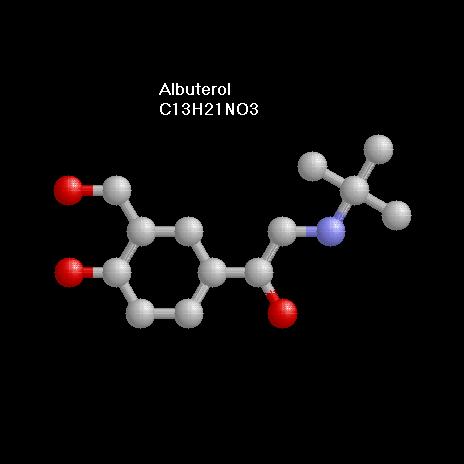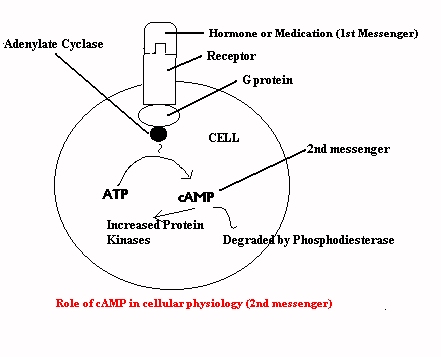 (5).
(5).
This paper reflects the research and thoughts of a student at the time the paper was written for a course at Bryn Mawr College. Like other materials on Serendip, it is not intended to be "authoritative" but rather to help others further develop their own explorations. Web links were active as of the time the paper was posted but are not updated. Contribute Thoughts | Search Serendip for Other Papers | Serendip Home Page |
Biology 103
2001 Second Web Report
On Serendip
It is a terrifying experience not being able to breath-feeling your chest tighten, hear the familiar wheeze, and feel your entire body tense up as each breath brings less and less satisfaction. I was six years old when I had my first asthma attack, and since then I have been learning about my case and trying various inhalers, pills, and nebulizers to keep my breathing under control. The only medication I have been on consistently all these twelve years has been my Albuterol inhaler. Albuterol is, in fact one of the most commonly prescribed treatments for asthma patients. However, beyond the usage instructions and side effects I knew little about it, and what I wanted to find out why, chemically, this inhaler helps relieve asthma symptoms.
When I was a little girl I was given a basic idea of what asthma was and how my inhalers helped. The nurse at the hospital told me that something was aggravating my lungs; in reaction, they were narrowing my air passages (1).. The medicine helps by preventing any further constricting of the passages. That explanation has sustained for me for over ten years, but I know there has to be a more thorough explanation of what is going on when I inhale Albuterol.
Also known as Proventil and Ventolin (depending on the vendor the drug), Albuterol is classified as a ß2 adrenergic bronchodilator (3).(4).. Despite the complicated name, this basically highlights the link between the drug and the ß2 adrenoreceptors (receptors in the cell) in mediating the dilation of the bronchi. Its empirical formula is C13H21NO3 and has a molecular weight of 293.3.
 (5).
(5).
So how does the Albuterol actually do its stuff? Well diameter of the airways in the lung are regulated, for the most part, by the smooth muscle. The pathways constrict when the amount of calcium (Ca++) increases within the soft muscle cells. Although there is the possibility that the calcium is coming from some source beyond the extracellular source, scientists believe that it originates from the sarcoplasmic reticulum within the cell itself(2).
The autonomic nervous system controls the smooth muscle and sends out the necessary chemicals for the regulation of the air passages. When the receptors of the soft muscle detect irritants, a chain of reactions carried through the vagus nerve, result in the production of acetylcholine (ACH). Upon its release, the certain other receptors-for the time being we're concerned with the M3 muscarinic receptor-are cued. When the M3 receptor links up with the ACH, another protein is activated which produces IP3 and diacycloglycerol from PIP2. The IP3 initiates the release calcium from the intracellular stores (2).. This increased concentration of calcium causes the airways to constrict and makes breathing difficult.
The saving grace for the ailing asthmatic is a chemical called cyclic adenosine monophosphate (cAMP). An increased concentration of this compound within the inner membrane of the cell stimulates yet another protein-kinase. This enzyme limits muscle contraction by adding a phosphate group to the other intracellular proteins. Adding the phosphate group to the PLC (the protein activated by the G protein) prohibits the conversion of PIP2 into IP3 and DAG and hence restricting the release of calcium into the cell (2)..
 (4).
(4).
In normal circumstances, the production of cAMP is regulated by the release of epinephrine (EPI or adrenaline) (6). The ß2 adrenergenic receptors have an affinity for epinephrine, the activation of which stimulates a G protein within the inner membrane of the cell. There is a domino effect and the G protein in turn activates adenylyl cyclase (AC) to catalyze the making of cAMP from existing ATP in the cell.
Albuterol is a ß2 adrenergenic bronchodilator, so it too is perceived by the ß2 receptors. The medication simulates the function of EPI in the reaction and allows the necessary activation of proteins to create cAMP. As shown in the diagram above, either the hormone epinephrine (or actually any catecholamine) or medication can be used as the first messenger in this reaction (2)(4). Although I was not able to find out exactly why one can be substituted for the other, it is noteworthy that the empirical formula of adrenaline is C9H9O3N (7), meaning that both chemicals contain the same elements differing in the number of carbon and hydrogen atoms.
The connection between adrenaline and Albuterol is logical-one of the more archaic asthma treatments (the one my eldest brother encountered) was to give injections of adrenaline. However, this was dangerous because of its jolting effect on the heart. Albuterol also is noted for a raised heart rate, but the side effect is still not quite as severe in most cases. Either way, the resulting regulation of cAMP and intracellular calcium release helps allow mucus to drain and decreases the resistance in the airway (4).
2) Discussion by Dr. Philippa Friday
3)Albuterol Inhalation, from RxList
4) Albuterol (Proventil, Ventolin), from Cowley College's Emergency Medicine Formulary
6) Epinephrine , from Encarta